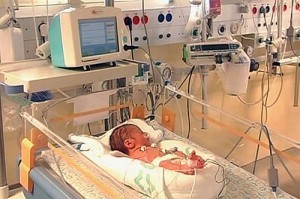Researchers from the Technion and Carmel Developed a Novel Device for Monitoring Respiratory Problems in Premature Babies
 Was given an editorial in a leading scientific journal under the heading: “Prevention is Better than Cure”; the novel device continuously monitors the breathing function of the premature baby, immediately detects the development of respiratory deterioration and helps in characterizing it, before the onset of distress that may lead to serious irreversible injury to the patients
Was given an editorial in a leading scientific journal under the heading: “Prevention is Better than Cure”; the novel device continuously monitors the breathing function of the premature baby, immediately detects the development of respiratory deterioration and helps in characterizing it, before the onset of distress that may lead to serious irreversible injury to the patients
The researchers, Dr. Dan Waisman from the Technion’s Rappaport Faculty of Medicine and Carmel Medical Center and Prof. Amir Landesberg of the Technion’s Faculty of Biomedical Engineering say that the device, called the “Pneumonitor”, continuously and systematically monitors the dynamics of premature babies’ breathing. It was tested successfully on mice, rats and rabbits in different disease models. “We simulated common conditions that occur in premature babies in the Neonatal Intensive Care Unit, as well as an animal model for asthma, and compared the operation of our device to that of competing devices”, they say. “We also tried the device in 63 cases in Carmel, Bnai Zion and Rambam Medical Centers. The device is now ready for FDA review”.
It has been reported that 45% of life threatening events that occur in a Neonatal Pediatric Intensive Care Unit go undetected by monitoring devices currently used, and were detected only by staff visual inspection of their patients. Even when the devices do detect a problem, the patient is already in distress, can develop life threatening complications and the event become dramatic, and it still remains for the doctor to identify the cause of the event.
The Pneumonitor has three miniature motion sensors that are attached to the infant on both sides of the chest and the upper abdomen. When respiratory deterioration is detected, the device signals an alarm before the onset of distress, and provides information that can assist in the diagnosis of the nature and location of the problem, and selecting the appropriate treatment. The motion sensors quantify the breathing effort and the symmetry of lung ventilation. The device displays data on the respiratory conditions and indicates changes in the level of ventilation.
Approximately 10% of all births worldwide are preterm, and an additional 10% of full term babies suffer complications and require tight respiratory supervision. Also, 15% of premature babies born under 1500 grams may die and an additional 15% suffer from serious complications such as mental retardation, severe handicaps, hearing and visual problems, and chronic lung disease. A significant percentage of these complications is related to respiratory management and care. That is why the early identification of respiratory distress in premature babies is so important.
Approximately 400,000 premature infants are born every year in the United States, and 30 thousand of these novel devices are needed for the premature baby wards alone.
The Technion has registered a patent for the device and has set up a company called “Pneumedicare”, located in Yokne’am and managed by Dr. Carmit Levy, who earned her Ph.D. from the Technion’s Department of Biomedical Engineering.
Above: The “Pneumonitor” in action. Photo: Technion Spokesman


